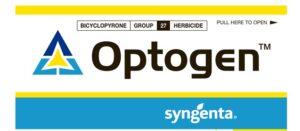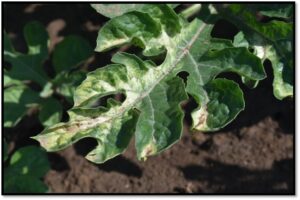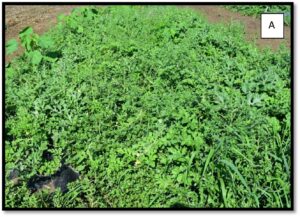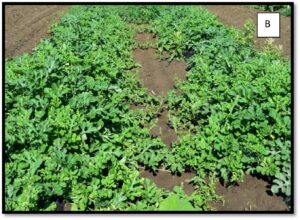What is Optogen®?
The active ingredient in Optogen® (Figure 1) is bicyclopyrone. Corn growers may recognize bicyclopyrone as one of the four ingredients in Acuron® herbicide. Bicyclopyrone is a Group 27 herbicide with pre- and post-emergence activity on select weed species. Group 27 herbicides inhibit an enzyme known as “HPPD”, resulting in an inhibition of carotenoid synthesis. Ultimately, symptomatic plants exhibit “bleaching” injury (white plant tissues) (Figure 2). This is the only Group 27 herbicide labeled for many of the registered crops. Rotating among herbicide Groups is one way to slow the onset of herbicide resistance.
Figure 2. Mild and temporary Optogen® bleaching symptoms on a watermelon leaf.
On what crops can Optogen® be used?
The current label includes broccoli, garlic, horseradish, onion, strawberry, sweet potato, and watermelon. It is anticipated that additional crops will be added in the coming years.
Important Notes:
The use on onions should be limited to muck soils. Use on mineral soils will result in crop injury.
Applications made to emerged weeds should target weeds 2” tall or less and include a non-ionic surfactant or crop oil concentrate.
Applications made to row middles should be directed or applied with a hooded sprayer to keep the herbicide off the crop.
What weeds are controlled by Optogen®?
Optogen® is supposed to provide control of pigweeds, velvetleaf, common ragweed, eastern black nightshade, and lambsquarters. Partial control of numerous other weed species is also expected. Like most herbicides, Optogen® will work best in an integrated weed management program. For example, in 2022 research trials, we used Optogen® as a layby application in plasticulture-grown watermelon. This followed a pre-plant application of Chateau® and Dual Magnum® (Figure 3). This combination of herbicides resulted in excellent control of pigweeds, velvetleaf, and annual grasses.



